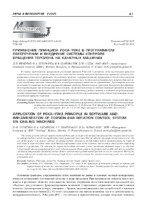Применение принципа Poka-yoke в программном обеспечении и внедрение системы контроля вращения торсиона на канатных машинах

Date
2025Publisher
Another Title
Application of Poka-yoke principle in software and implementation of torsion bar rotation control system on cabling machines
Bibliographic entry
Применение принципа Poka-yoke в программном обеспечении и внедрение системы контроля вращения торсиона на канатных машинах = Application of Poka-yoke principle in software and implementation of torsion bar rotation control system on cabling machines / Д. О. Ивченко, О. А. Штаркина, В. В. Шаповалов, Д. Ю. Судас // Литье и металлургия. – 2025. – № 3. – С. 61-65.
Abstract
В статье представлены программная реализация принципа Poka‑yoke и внедрение системы контроля вращения торсиона на канатных машинах, позволяющие существенно снизить издержки производства, вызванные влиянием оборудования и человеческим фактором. Цель данного проекта – совершенствование программного обеспечения канатной машины, направленное на выявление скрытых дефектов (в том числе по длине металлокорда) для снижения доли технически неизбежных отходов у потребителя и несоответствующей продукции на производстве. Рассмотрены решения по усовершенствованию системы улавливания обрывов, введения дополнительных триггеров для исключения образования «короткомеров» при изготовлении металлокорда, снижения количества несоответствующей продукции (исправимой и неисправимой), вычисления и своевременного устранения сбоев в работе машины и контроля непреднамеренных ошибок операторов. Разработаны и внедрены программное обеспечение контроля и счета длины металлокорда, система контроля вращения торсиона.
Abstract in another language
The article presents software implementation of Poka‑yoke principle and introduction of torsion bar rotation control system on cabling machines, which can significantly reduce production costs caused by the influence of equipment and human error. The aim of this project is to improve software of cabling machine, allowing to identify hidden defects (including along the length of steel cord) in order to reduce share of technically unavoidable waste at the customer, and to reduce share of non‑conforming products in production. The solutions for improving breakage detection system, introducing additional triggers to eliminate “short‑length” during production of steel cord, reducing amount of non‑conforming products (correctable and non‑correctable), calculating and promptly eliminating machine failures and monitoring unintentional operator errors are considered. During the process software for monitoring and counting length of steel cord and a torsion bar rotation monitoring system were developed and implemented.
View/
Collections
- № 3[16]
